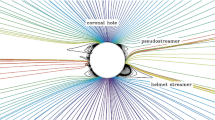Abstract
The radio observations of the coronal streamers obtained using Clark Lake radioheliograph at 73.8, 50.0, and 38.5 MHz during a period of minimum activity in September 1986 are presented. Streamers appear to correlate with two prominent disk sources whose intensities fluctuated randomly. The variations in half-power diameter of the radio Sun are found to correspond with the variations in the white-light extents of the coronal streamers. It appears that the shape of the radio Sun is not a function of the phase of the solar cycle; instead it depends on the relative positions of the streamers in the corona. The observed peak brightness temperatures,T B , of the streamers are found to be very low, being ≃6 × 104 K.
We compute the brightness temperature distribution along the equator by tracing the rays in the coronal plasma. The rays are deflected away by the streamers before reaching the critical density level, whereas they penetrate deeper into the coronal hole for small angles between the line of sight and the streamer axis. As a consequence, it is found that the streamers and coronal holes appear in the calculated equatorial brightness distribution as irregular brightness depressions and enhancements, respectively. The fine structures are found to disappear when the scattering due to small-scale density inhomogeneities is included in the ray-tracing calculations. The required relative level of density fluctuations, ∈1 = ΔN/N, is found to be greater than 12% to reduce the peak brightness temperature from 106 K to 6 × 104 K for all the three frequencies.
Similar content being viewed by others
References
Alissandrakis, C. E., Lantos, P., and Nicolaidis, E.: 1985,Solar Phys. 97, 267.
Avignon, Y. and Malinge, A. M.: 1961,Compt. Rend. 255, 2859.
Axisa, F., Avignon, Y., Martres, M. J., Pick, M., and Simon, P.: 1971,Solar Phys. 19, 110.
Dulk, G. A. and Sheridan, K. V.: 1974,Solar Phys. 36, 191.
Dulk, G. A., Sheridan, K. V., Smerd, S. F., and Withbroe, G. L.: 1977,Solar Phys. 52, 349.
Erickson, W. C., Mahoney, M. J., and Erb, K.: 1983,Astrophys. J. Suppl. 50, 403.
Erickson, W. C., Gergely, T. E., Kundu, M. R., and Mahoney, M. J.: 1977,Solar Phys. 54, 57.
Hoang, S. and Steinberg, J. L.: 1977,Astron. Astrophys. 58, 287.
Kundu, M. R.: 1987, in R. C. Altrock (ed.),Solar and Stellar Structure and Dynamics, A Festschrift in Honor of Dr John W. Evans, National Solar Observatory, Sacramento Peak, Sunspot, New Mexico, p. 192.
Kundu, M. R., Gergely, T. E., and Erickson, W. C.: 1977,Solar Phys. 53, 489.
Kundu, M. R., Gergely, T. E., Turner, P., and Howard, R.: 1983,Astrophys. J. 303, 436.
Kundu, M. R., Gergely, T. E., Schmahl, E. J., Szabo, A., Loicaono, R., Wang, Z., and Howard, R. A.: 1987,Solar Phys. 108, 113.
Kundu, M. R., Schmahl, E. J., Gopalswamy, N., and White, S. M.: 1989,Adv. Space Res. 9, 41.
Lantos, P., Alissandrakis, C. E., Gergely, T., and Kundu, M. R.: 1987,Solar Phys. 112, 325.
Leblanc, Y.: 1970,Astron. Astrophys. 4, 315.
Leblanc, Y. and Le Squeren, A. M.: 1969,Astron. Astrophys. 1, 329.
Moutot, M. and Boischot, A.: 1961,Ann. Astron. 24, 271.
Newkirk, G.: 1961,Astrophys. J. 133, 982.
Pawsey, J. L. and Bracewell, R. N.: 1955,Radio Astronomy, Oxford University Press, Oxford, p. 83.
Riddle, A. C.: 1974a,Solar Phys. 35, 153.
Riddle, A. C.: 1974b,Solar Phys. 36, 375.
Sastry, Ch. V., Shevgaonkar, R. K., and Ramanuja, M. N.: 1983,Solar Phys. 87, 391.
Sastry, Ch. V., Dwarakanath, K. S., Shevgaonkar, R. K., and Krishan, V.: 1981,Solar Phys. 73, 363.
Sheridan, K. V.: 1970,Proc. Astron. Soc. Australia 1, 304.
Sheridan, K. V.: 1978,Proc. Astron. Soc. Australia 3, 185.
Sheridan, K. V. and McLean, D. J.: 1985, in D. J. McLean and N. R. Labrum (eds.),Solar Radiophysics, Cambridge University Press, New York.
Steinberg, J. L., Aubier-Girand, M., Leblanc, Y., and Boischot, A.: 1971,Astron. Astrophys. 10, 362.
Thejappa, G. and Kundu, M. R.: 1992,Solar Phys. 140, 19 (Paper I).
Wang, Z., Schmahl, E. J., and Kundu, M. R.: 1987,Solar Phys. 111, 419.
Author information
Authors and Affiliations
Additional information
On leave from Indian Institute of Astrophysics, Bangalore 560034, India.
Rights and permissions
About this article
Cite this article
Thejappa, G., Kundu, M.R. The effects of large- and small-scale density structures on the radio emission from coronal streamers. Sol Phys 149, 31–49 (1994). https://doi.org/10.1007/BF00645176
Received:
Revised:
Issue Date:
DOI: https://doi.org/10.1007/BF00645176




